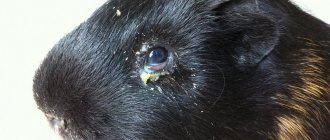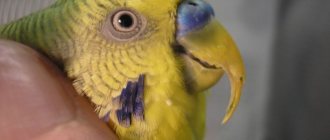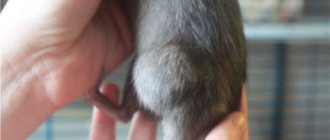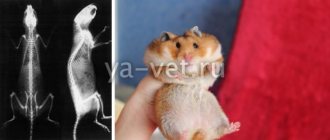Many novice breeders, purchasing the following breeds of individuals of the hamster order - Djungarian and Syrian, begin to ask questions when they see that the hamster has black spots on the sides. There are a sufficient number of questions on the forums related to their presence on the body of animals. Many consider them “sores” and wonder whether they will harm humans and other pets. There is no need to sound the alarm, since these are peculiar anatomical features of the animals, explained by the protrusion of scent glands.
Lichen
This is a skin disease caused by a viral infection or microscopic fungi. Depending on the pathogen, there are two types of lichen: ringworm and pink lichen.
Rodents with weakened immune systems, mechanical trauma to the skin, and elderly animals are at risk of infection.
The following symptoms are typical for lichen:
- baldness;
- the appearance of inflamed areas;
- itching;
- loss of appetite.
If the disease is confirmed, the sick hamster is isolated from other pets, the cage, bowls, wheel and all objects that came into contact with the infected animal are disinfected. The most effective means for this will be a formaldehyde solution or a sulfur-carbolic mixture.
For treatment, antifungal drugs are used, which are prescribed by a specialist, who will also tell you the dosage and duration of the course. Hair is removed from damaged areas of the body as they are contaminated with fungal spores.
Dried crusts are softened and cut off, the area is treated with salicylic ointment, and the edges are treated with iodine. It is also recommended to support your pet’s body with immunostimulating drugs and probiotics during the treatment period.
Ringworm
A characteristic feature is rounded bald patches on the front of the body and muzzle.
Further, these bald spots become inflamed and form purulent ulcers, through which the fungus enters the body, poisoning it with toxins and causing itching throughout the body.
The disease is transmitted from humans to animals and vice versa.
Pityriasis rosea
The main difference from other skin diseases is the appearance of hairless pink areas of skin, more saturated at the edges than in the center.
It is not dangerous for humans - unlike trichophytosis (the scientific name for ringworm), it is not transmitted through household contact.
“Male” glands in individuals of the Syrian breed
In individuals of the Syrian breed, black spots, which are scent gland tubules, may differ in appearance. There are cases when owners do not notice their presence, since they hardly stand out in the fur of their pets. In others, they can be large or soapy in size, in the form of bulges or flat, pale or dark in color. Sometimes the black spots are so small that they look like a cluster of small dots in one place.
The glands of males are more noticeable than those of females. They have the appearance of warts and are distinguished by their convexity and roughness. If you notice that your pet is rubbing its sides against the bars of the cage or some parts of its body are wet, do not worry. In this way, he marks a new territory or attracts the attention of a female during estrus.
Often the black spot a hamster has changes its appearance. In such situations, after an examination, veterinarians can identify the following conditions of the pet:
- being in a stressful situation;
- development of inflammatory processes;
- development of cancer.
Treatment in these cases can be prescribed either conservatively, using only medications, or surgically, requiring immediate surgical intervention.
Scab
The causative agent is the fungus Achorion Schoenleini. Hamsters get the disease through contact with sick animals or humans, through insect bites and contaminated equipment.
It looks different depending on the stage of development.
Main symptoms:
- white scaly plaque on the ears, eyebrows and tip of the nose;
- formations are round in shape with a diameter of up to 1 cm;
- Over time, the affected areas become covered with blisters, which gradually increase in size and form crusts with hairs in the middle.
A sick animal must be isolated from other pets, the room and objects with which it has been in contact must be treated with disinfectants.
Establishing an accurate diagnosis will allow the veterinarian to select an antifungal drug, establish the dosage and course of treatment. It is also necessary to treat the affected areas of the skin - scales and scabs should be softened with oils and carefully removed.
Treat areas cleaned of crusts daily with iodine tincture mixed with alcohol solutions of glycerin, creolin or Lysol.
Dermatophytosis
A skin disease caused by dermatophyte fungi that feed on hair and dead cells. The infection is also known as ringworm because the red lesions appear in rings on the skin.
There is severe peeling along the edges of the spots, while the surface in the center is absolutely healthy.
Dermatophytosis poses a threat to households - it can be transmitted from animals to humans.
Treatment is selected by a specialist, usually using external agents such as Yam or Fungin ointment, Zoomekol aerosol, chlorhexidine, and sometimes oral medications. The duration of therapy is 1-2 months.
Don’t forget about disinfecting the premises – fungal spores are viable for up to 4 years.
Fleas
They are extremely rare in hamsters; infection mainly occurs from other domestic animals - cats or dogs.
If your pet develops itching, skin rashes, baldness over large areas of the body, dandruff, and crusts, a flea infestation can be suspected. In this case, it is necessary to take urgent measures to eliminate them.
Anti-flea medications used for dogs and cats are not suitable for hamsters and can be harmful to their health. To get rid of fleas, special antiparasitic agents for rodents are used.
Scent glands in "jungarians"
Unlike the Syrian breed, individuals of the order of hamsters of the Djungarian breed have distinctive black spots on the stomach. By the way, they develop only in males and are absent in females. The animals mark their territory by scratching their bellies against various objects in the cage. For this reason, you should make sure that the accessories located in it do not have sharp corners.
As you can see, the black spots present on the hamster’s body are a common anatomical formation that should not be treated. However, if the black spot appears spontaneously, increases in size, and the animal’s condition begins to deteriorate, it is worth showing it to a specialist at a veterinary clinic. Spots that appear in large quantities on the body of animals can become a herald of the development of serious inflammatory and oncological processes.
Ticks
Ectoparasites on a hamster are quite common, but they do not bother the animal, since their number is usually small.
For a clear clinical picture of the disease to appear, they must be accompanied by vitamin deficiencies, weakened immunity, or poor hygienic conditions.
Causes and symptoms. Rodents are most often affected by Demodex mites, which are the causative agents of demodicosis.
With this disease, the pet experiences itching, dandruff, increased hair loss, dry and irritated skin.
Hamsters are often parasitized by Notoedres mites, the causative agents of notoedrosis.
This pathology is characterized by severe itching, hair loss, and the formation of dry crusts and dandruff on the face, ears, cheeks and limbs.
To get rid of itching, animals itch, the skin is damaged, and this leads to infection.
Rodents become irritable, refuse food - the result is exhaustion, which can be fatal.
Another type of scabies is caused by the scabies mite Sarcoptes anacanthos. With sarcoptic mange, pets itch severely, damaging the skin and infecting the wounds.
Pustules form throughout the body, which turn into scabs and scabs.
Without timely and effective help, a small pet may die 3-4 weeks after the first symptoms appear.
To get rid of ticks, use local preparations in the form of powders, sprays, ointments, shampoos with selenium sulfide or oral insecticides. Diagnosis and treatment should be carried out by a veterinarian.
The drugs metrifonate and cythioate showed good results. For sarcoptic mange, infected animals are bathed in a 0.5% bromocyclene solution.
To cure a hamster from notoerdrosis, the affected areas should be treated with a 3% solution of the drug SK-9, sulfur ointment, the course of recovery is 7-10 days.
In case of bream, the pet must be isolated from other individuals, and the cage and objects with which it has been in contact must be disinfected. This will prevent re-infection.
The hamster has spots. What could it be?
Owners quite often notice black spots on their hamster’s body.
Don't rush to sound the alarm. These spots may not always be dangerous to the life and health of the animal. Black symmetrical spots on the sides are scent glands.
Syrian and Djungarian hamsters use scent glands to mark their territory. Their size and color may vary. Spots on hamsters
They can be large and convex, and in some they are very small and unnoticeable. Some owners do not notice these spots at all and this is quite normal.
In males, the scent glands are much more pronounced. They are convex and have a slight roughness. Sometimes rodents rub against the bars of the cage. At this point, you can notice that their sides are wet. In this way they mark their territory or try to attract the attention of the female. This is a natural phenomenon. There is no reason to worry.
If your hamster has black spots
change, you should consult a doctor. Changes may indicate stress, inflammation, or even cancer in the animal. Only a veterinarian can make a correct diagnosis after a full examination. Treatment can be either medication or surgery.
In Djungarian hamsters, the location of the scent glands is slightly different. Hamster has spots
are on the tummy. They are present only in males. They mark their territory by scratching their bellies. Try to remove all sharp objects from the cage so that the animal does not get hurt.
What to do if your hamster has spots?!
If you notice a red spot on your hamster,
then you should contact a veterinarian. These can be various skin diseases. They pose a great danger to small pets. Treatment of skin diseases should begin when the first symptoms appear. Weakness, partial refusal of food and water, bad mood, drowsiness. This can be lichen, dermatitis, damage by ticks, fleas and other parasites.
Prevention measures
To avoid infection with skin diseases, as well as to prevent relapses, you must adhere to the following recommendations:
- nutrition should be balanced;
- the water in the drinking bowl should be changed regularly so that it is always fresh;
- hygiene rules must be observed;
- periodically treat the premises with disinfectants;
- carry out vaccinations against major serious diseases.
These simple rules will support your pet’s immunity and prevent infection from developing.
Causes of hair loss
They can be divided into two categories: natural and pathological shedding.
The pet is healthy, active, eats well, but the fur is very loose.
Seasonal shedding - old wool is replaced by new. Occurs intensely on the abdomen and the inside of the legs, and almost imperceptibly on the back.
Age - on average, hamsters live three years, a two-year-old rodent is already considered old, and it is quite natural that he began to go bald.
Hormonal changes – during pregnancy, females can experience intense hair loss. Also, bald spots on the abdomen appear in hamsters that feed their young.
Sometimes hair loss can indicate health problems or improper care. The causes of baldness should be excluded and checked in order:
Filler - some of them can cause an allergic reaction in a rodent.
Nutrition - it must be balanced with all the necessary elements so as not to cause vitamin deficiency. Sometimes hamsters develop intolerance to some fruit or vegetable, it is worth finding out by elimination.
Stress – constant change of environment can lead to baldness.
Diseases are one of the most dangerous causes. Only a specialist can make a diagnosis and prescribe effective treatment.
Fungal diseases of hamsters: symptoms and treatment
Fungal diseases of hamsters: symptoms and treatment. Infections caused by spores of various types of fungal flora. Diagnosed only by veterinary specialists. Ratologists at the Vetmaster veterinary center will help diagnose fungal infections and prescribe correct and effective treatment for your pet, which consists of local and systemic antifungal therapy and immunostimulation of the animal’s body. Of the existing fungal infections, the most common are:
Actinomycosis. It is caused by the so-called radiant fungus of the genus Actinomyces, which enters the hamster’s body with infected cereal plants. Symptoms: damage to the bones and muscles of the jaws, gums and teeth, the junction of the incisors is displaced and they are worn incorrectly, discomfort occurs while eating.
Dermatophytosis. Caused by fungi of the genus Trichophyton and Microsporum. Dangerous for humans. Symptoms: gray, dry, flaky patches of baldness on the rodent’s body, itching, scratching.
Scab. Caused by a fungus of the genus Achorion. Symptoms: loose, abundant peeling in the ears and eyes, the presence of gray small blisters, then crusts and sores, itching, scratching.











